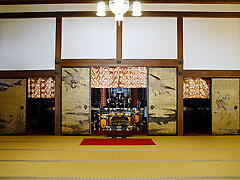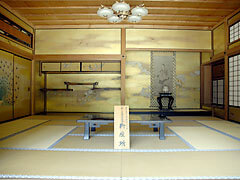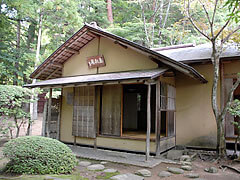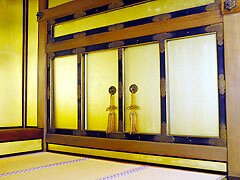Temple Guide


Main Gate
A charismatic founder, Kūkai (774-835), posthumously named Kobo Daishi, studied esoteric Buddhism in China and established the temple complex on Koyasan in 816. Kongobuji Temple is a headquarter of the Shingon sect of Esoteric Buddhism.
At the main entrance of Kongobuji Temple, you will find paper lanterns with two different crests. On the right is “three commas” insignia, which is the crest of Nyutsuhime Shrine whose Shinto deities are the guardians of Koyasan.
On the left is the paulownia flower insignia, which is the crest of the Toyotomi clan lead by a samurai ruler, Toyotomi Hideyoshi. A unifier of Japan, Toyotomi Hideyoshi in they late 16thcentury had prepared to attack and destroy Koyasan, but a Buddhist monk named Ogo, also known as Mokujiki Shonin (Wood eating saint) helped to negotiate the safety and existence of Koyasan.
Instead, Hideyoshi, let Mokujiki build Kozanji Temple in this precinct. Additionally, at the site of the present main temple, he built Seiganji Temple in memory of the spirit of his beloved mother in 1593.
Since then, two temples had existed here until 1869. One year after the Meiji Restoration when the government drastically changed, the two temples were consolidated into one and renamed Kongobuji Temple. The main temple you see today was rebuilt in 1863 after several fires.
To remember the connection with Toyotomi Hideyoshi, Kongobuji Temple has used the crest of Toyotomi Family as its own temple crest together with the other one. The crests must have witnessed many ups and downs of the temple’s history.
The current main gate was rebuilt in 1862. In old times, the use of the main gate was limited to the emperors, members of the royal family and the chief priests of Koyasan. Ordinary monks and general visitors used the side gate on the right, or they used the another gate, named” Eka Mon”, located in the east of the temple. This is just one of many examples of traditional strict rules existed in Koyasan.
The gate is photogenic with the weeping cherry blossom in spring, the rhododendron in early summer, the Japanese maple in autumn, and the pure white snow in winter.

Tensuioke (Rain Barrel)
The roof of Kongobuji Temple has barrels, which is unique to this temple. They are rain barrels against fire hazards called “Tensuioke”. The rainwater accumulated in the barrels were used to dampen the roof in case of fire. The”Tensuioke” will let you imagine the efforts of ancient monks hurriedly climbing up the roof and sprinkling the rain water to protect the temple against flying sparks.
The roofs are made using a roofing technique called “Hiwadabuki.” It is a traditional Japanese roofing style of laying countless number of cypress bark pieces and nailing each shingle with bamboo nails. They are laid and fixed each other precisely with a 1-2 cm overlap. Because of this roofing technique the graceful curve of the roof is possible.

Kyozo (Scripture Storehouse)
A structure with a raised floor is a “kyozo”, a repository for sutras. “Kyozo”, in Japanese Buddhist architecture, is supposed to be built separately from the main building so that it can save important documents, chronicles of the temple, sutras and ritual objects in the case of the outbreak of fire. This “Kyozo” is said to be constructed in 1679 by the donation of a merchant in Osaka.

Shoro (Bell Tower)
A two-storied trapezoidal building is “Shoro”, a bell tower, presumably being rebuilt in 1864. Although the bell cannot be seen from outside, an old bell is suspended in the upper story.
This bell tower is designated as a prefectural cultural property because of its old beautiful “Hakamagoshi” gabled roof style. The traditional Japanese architectural term “Hakamagoshi” derives from the lower part of a structure expanding wider like “hakama”, loose trousers worn over a kimono as a part of traditional Japanese formal dress.
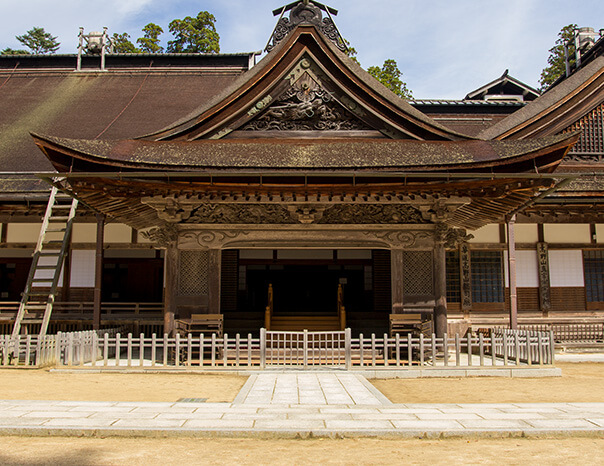 Daigenkan
Daigenkan Kogenkan
Kogenkan
Multiple Entrances
The temple remains Kongobuji Temple’s traditional way of using entrances. The big entrance has been used for the Emperor, the imperial family, and Koyasan’s chief priests and officials. The smaller one was used by high priests and general priests. Gates symbolized authority and power in the old Japan.

Main Hall and Alter Room
The Main Hall is a place for holding important ceremonies such as “Hana Matsuri”, Shakamuni Buddha’s Birthday celebration and Buddhist memorial services such as “Joraku-E”, memorial service for the Shakamuni Buddha entering Nirvana.
The Altar Room enshrines the founder of Koyasan, Kukai (Kobo Daishi), and on both sides are displayed the mortuary tablets for successive generations of Emperors of Japan as well as mortuary tablets for successive generations of Koyasan’s chief abbots.
Koyasan received patronage and visits from the feudal lords, the nobility and the Imperial court. One of the highlights of this temple is beautiful paintings on sliding doors. Although the main building was destroyed by fires several times, the paintings donated by those who visited Koyasan have survived the fires over the centuries . The painting in this room,“Flocks of Cranes and Pine Trees” was presumably painted by Saito Toshitsu in 17th century.
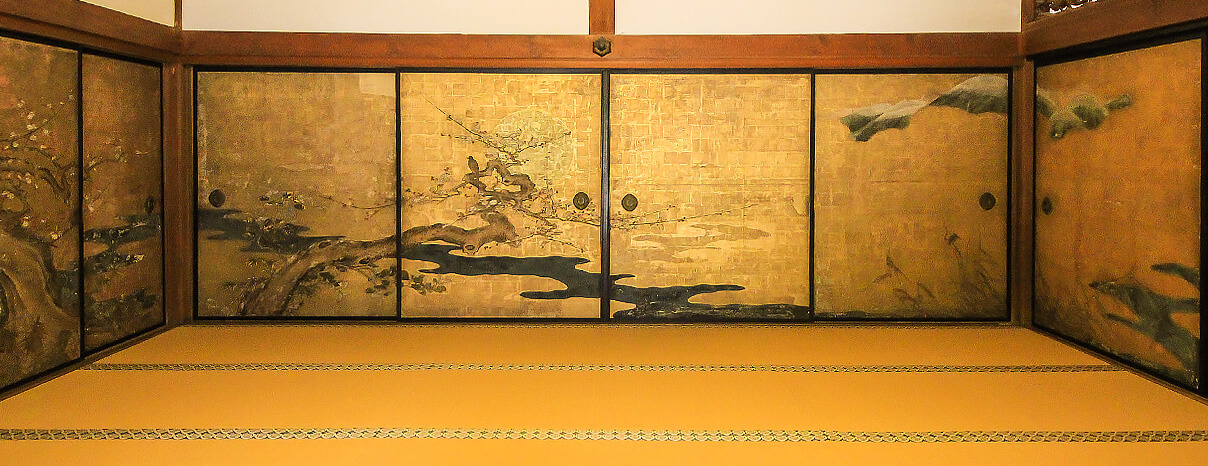
Umenoma (Plum Room)
Due to the painting of Plum, this room is called “Plum Room.” The painting “Plum, Moon, and Stream” was painted by the great genius of Kano School, Kano Tanyu (1602-1674)
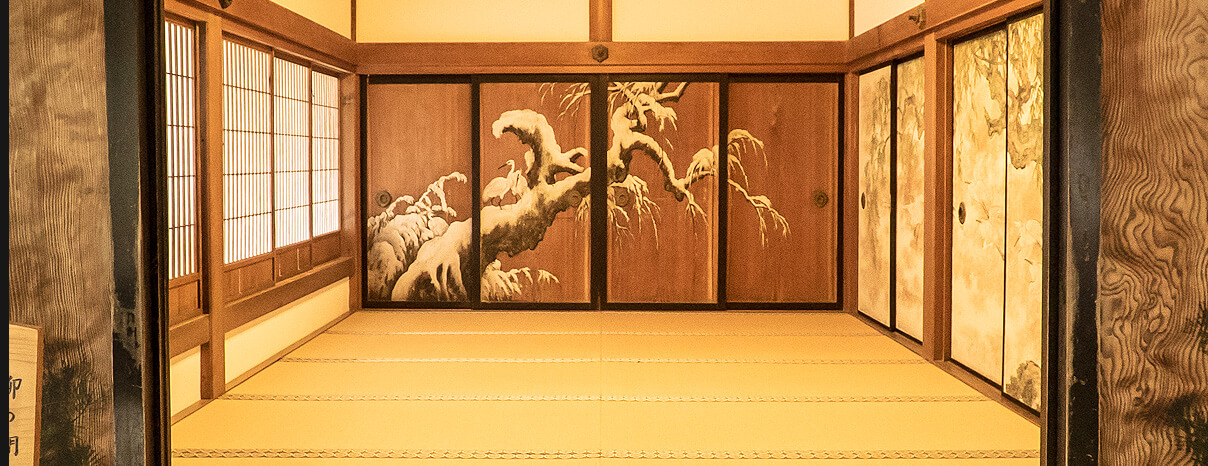
Yanaginoma (Willow Room)
Because of the painting, “Willow Tree and Heron “painted by Yamamoto Tansai, this room is named “Willow Room. “
Most Japanese people cannot pass by the “Willow Room” without a shred of interest. This is the site where Toyotomi Hidetsugu, (1568~1595) second generation Kampaku (chief imperial advisor), committed ritual suicide. Hidetsugu was a nephew of Toyotomi Hideyoshi, the ruler of Japan at that time.
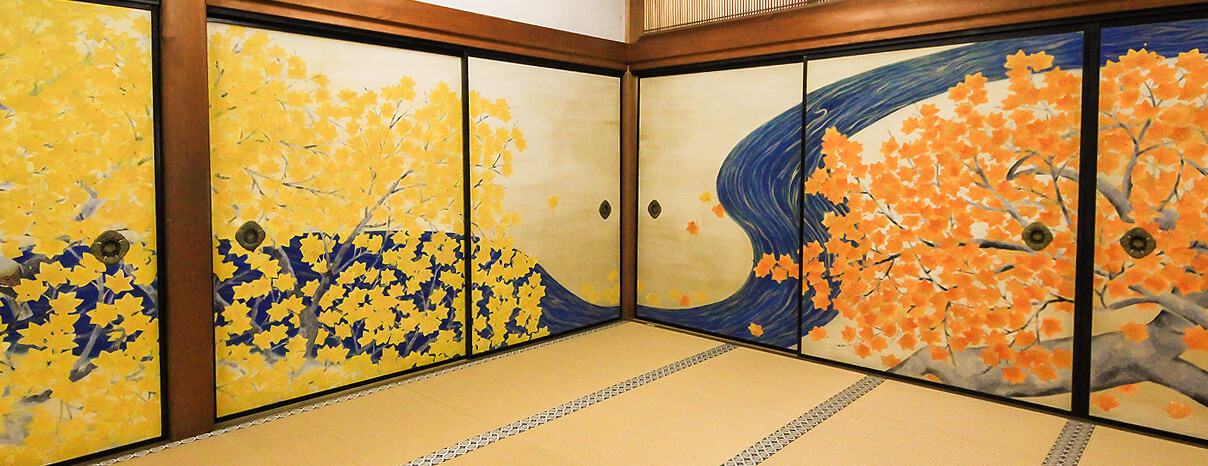
Temple Annex (Betsuden)
Walking along a corridor, you will enter an annex, the Betsuden. It was built in 1934 to commemorate the 1100th anniversary of Kukai’s entrance into eternal meditation.
The Betsuden is decorated with the paintings by Moriya Tadashi.
The sliding door paintings features Kukai’s travel to China to study esoteric Buddhism. On the other side of the rooms, there are paintings of beautiful flowers and autumn leaves.

New Temple Annex (Shin Betsuden)
In 1984, at the time of the 1150th anniversary since Kukai’s entrance into eternal mediation, this new temple annex, the Shin Betsuden,” new hall for resting” and the rock garden, Banryutei were established. In the giant 169 tatami mat room, visitors will be served with a cup of tea and a piece of rice cracker. You will have a chance to see a priest deliver a sermon to the visitors.

Banryu-tei
The Banryu-tei,” Garden of the Guardian Dragons” is the largest rock garden in Japan, 2340 square meters in size. 140 stones depict a pair of dragons emerging from a sea of clouds to protect Okuden, the special room in the center of the garden.
The stones representing the dragons are granite from Shikoku, the place of Kukai’s birth, and the white river sand representing the sea of clouds comes from Kyoto.

Okuden(private)
The Okuden,” inner hall” in the center of the rock garden is a special room for noble visitors, and was built in 1934 at the time of the 1100th anniversary of Kukai’s entrance into eternal meditation. Except on the day of Kukai’s birthday and on some special events, this room is not open to the public. Japanese painter Ishizaki Koyo (1884~1947) left his last great works, “Yukiyama Kashin” (Flower news from snow mountain), depicting the Himalayas and the Himalayan rhododendron here on the sliding doors.

Shin Shoin and Shin Sho-an (private)
(Photo:left) Shin Shoin served as lodging for the late Emperor Showa and Empress Kojun at the time of The Kuroshio National Athletic Meet held in Wakayama prefecture in 1971.
(Photo:right) Shin Sho-an is a full-fledged tea ceremony house donated by the founder of Panasonic, Konosuke Matsushita in 1964 at the time of 1150thcommemorative year since Koyasan’s founding. It was named Shinsho-an by the late Eisaku Sato, former Prime Minister of Japan.
Both interiors are not ordinarily open to the public.

Ajikan Dojo
Ajikan Dojo is a place to practice Esoteric Buddhist meditation, Ajikan (Meditation on the Sanskrit character “A”).
Ajikan is a form of meditation unique to Esoteric Shingon Buddhism. Kobo Daishi (Kukai) is said to have introduced this into Japan when he came back from China with the doctrine of esoteric Buddhism in the 9th century. The priests and lay people have traditionally practiced it for centuries. Innovative Kukai emphasized that we could become a Buddha within this very lifetime, not after death. Ajikan meditation is a method to try to attain unity with Buddha by concentrating on a drawing of the Sanskrit syllable ‘A’.

Jodan no Ma
The Jodan no Ma “Higher Platform Room” used to be a reception room for visiting emperors and now it is used for Koyasan’s major ceremonies.
Emperors and retired emperors sat on the higher platform. Behind small tasseled sliding doors on the right is the Musha Kakushi,” Room to hide samurai bodyguards” to protect emperors just in case of surprise attack. The room is highly prestigious with the walls completely covered in gold leaf, and with the ceilings coffered.

Courtyard
The garden is enjoyable in every season. In the late spring, the rhododendron will be in full bloom in hues of red and white, the Natural Treasure of Japan, the Japanese Forest Green Tree Frog laying its eggs toward the rainy season in early summer, colored leaves in autumn, and white snow in winter. The Japanese forest green tree frog, a species endemic to Japan, is unique in laying white foam-like egg in leaves and branches overhanging a pond.
The garden is told to have been made in the Edo period, and it was said that around the pond, stood Japanese cedar, Japanese cypress, red pine, hemlock, fir, and umbrella pine tree called “Koya-maki”. They are called “the six tree species of Koyasan”.
Since ancient times, according to the teaching of Kukai, the forest of Koyasan was preserved by promoting so-called “planting the six tree species of Koyasan”, which is useful to sustain forest diversity as well as to make use of the trees as timber to reconstruct temples.
The umbrella pine is a beautiful indigenous evergreen and grows straight and tall. Especially in Koyasan, it has been planted everywhere. The umbrella pine tree “Koyama-maki” was made Prince Hisahito’s symbol when he was born in 2006. Prince Hisahito is the son of Crown Prince and Princess Akishinomiya.

Okushoin
The Okushoin, inner drawing room, was a resting place for the visiting Imperial family. There is a sunken hearth and a square chimney above it to heat the room in winter.
The picture on the sliding doors are the works by Unkoku Toeki (1591-1644), and his son Unkoku Toji (1615-1671). They inerited the artistic style of sesshu, master of the Japanese Sumie, monochrome painting.
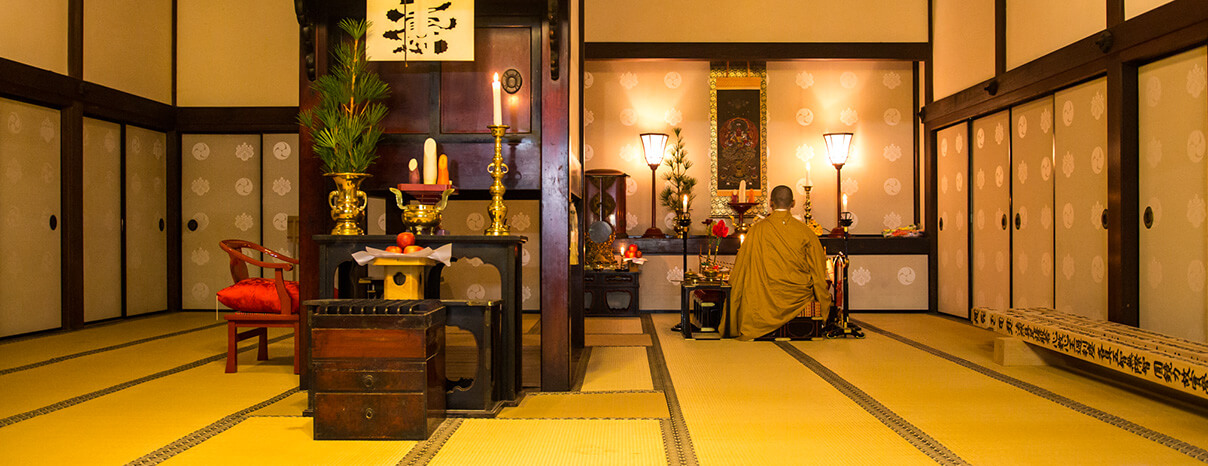
Irori-no-ma (room with open hearth)
Koyasan is situated 800 meters above sea level. To survive the extremely cold winter weather, monks gathered in the so-called Tsuchimoro “Earth Room”. In the center of the room there is a sunken hearth to heat the room. To keep the heat in, the wall is traditional Japanese earthen wall. There is a chimney like square facility built with four pillars and four walls above the sunken hearth so that the smoke will go outside through it. This is unique to Koyasan, although the” Tsuchimuro facility” used to be common in medieval Japan. The fire of the sunken hearth warms the room and the people’s hearts who gather for the Joraku-e Ceremony on the night of February 14th every year.
One of the few remaining masters of “nihonga” painting, Hiroshi Senju dedicated his sublime waterfall and cliff images to the sliding doors in this room and the tea room. In his works, a minimalist visual language rooted in Abstract Expressionism is combined with ancient painting techniques unique to Japan.

Kitchen
The Kitchen is now only used for a special religious ceremony. The high smoke-blackened ceiling with very thick beams speaks of the long history of this kitchen which provided meals for countless number of monks since the Edo period. Spring water is collected in a water tank made of “Koya-maki” (umbrella pine tree) which was grown in Koyasan.
There is a wooden food storage rack hanging from the ceiling. The white paper attached to the storage is to keep rodents away from the food.
The chimney duct for charcoal fire is incredibly big as safeguard against fire. There are three large rice cauldrons. Each cauldron could cook 98kg rice and three cauldrons could feed two thousand people at one time.
The Kitchen God is enshrined above the rice cauldrons.
